 Winning Hands Massage
Winning Hands Massage
Craniosacral Therapy (CST)
The underlying principle of Craniosacral Therapy and its predecessor Cranial
Osteopathy is that the cranial bones can become stuck along their suture
lines, resulting in imbalanced flow of the cerebral spinal fluid and other
associated dysfunctions. Treatment consists of very gentle, very subtle
“adjustments” of the bones in the cranial vault to free up those
restrictions to restore proper function. In addition, there is hydraulic
pumping of the Cerebral Spinal Fluid between the Cranial cavity and the
Sacrum.
The single biggest argument posited by the AMA for decades against
Osteopaths and Chiropractors has been that everyone KNOWS that the cranial
bones fuse into a solid ball and anyone who says otherwise is an obvious
quack. Well, anatomy was never taught this way in either Europe or Asia. It
was ONLY in the United States. Secondly, very detailed tests conducted at
the University of Michigan in the 1980’s conclusively proved that the
cranial bones do NOT fuse together. It is my understanding that medical
schools in the United States are now teaching that the bones don’t fuse
after all, but they still do not teach the significance of that.
In brief, the movement of the CSF generates an internal “rhythm” that can be
felt by trained practitioners. The two main ones (both at a 3-5 second
cycle) are out and back from the body’s mid-line based on the “paired” bones
and from the head toward the feet and back based on the “single” bones.
Paired would be arms, legs, ribs, parietal and temporal bones in the
cranium. Single would be spine, sternum, frontal and occipital bones.
Because of the interconnectedness of the entire body, very slight
misalignments anywhere can cause major dysfunction elsewhere. A perfect
example would be falling from one’s bike as a child, landing on the
tailbone, causing the tailbone to be bent out of position. This is extremely
common and only rarely identified and addressed. That misaligned tailbone
can, among other things, directly cause TMJ problems.
The two pieces of CST treatment work that I find to be almost universally
needed are called the Cranial Base Release and the Sphenoid Adjustment. The
Cranial Base Release addresses a stuck O-A joint at the base of the skull. I
have found this to be needed for virtually every person I have worked on in
the last two years.
Cranial Base Release
The normal/typical way it is done is with the person supine on the table.
The head and neck are rested on the finger tips as shown in the photo below.
The finger tips are at the very base of the skull under the Occipital Ridge.
Weight of the head and gravity are all that are needed for the release to
occur. As the release occurs, the back of the head will drop toward the
table into the practitioner’s hands and the chin will rise toward the
ceiling.
It is typically done on a table but can also be done either sitting or
standing behind the person being worked on. One hand applies gentle pressure
against the forehead. This pressure substitutes for gravity. There are two
ways to position the hand at the base of the skull. One is with the palm
facing downward. The other is with the palm facing up. Use whichever is more
comfortable for the position at the time. One advantage of standing behind a
sitting person and using the palm down hand position is that it is easier to
stabilize the head and neck if necessary if the individual goes into a
spontaneous unwinding.
Sphenoid Adjustment
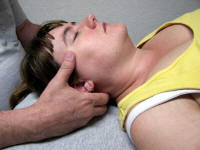 The Sphenoid is a butterfly (or bat) shaped bone behind the eyes. It has a
section (the Vomer) that rests along the upper side of the hard palette, and
articulates with the Occipital bone at the base of the skull. The hydraulic
action of the cerebral spinal fluid causes the sphenoid to rock toward the
feet and back. In more cases than not, I find this to be stuck or erratic.
The significance is that the rocking motion of the sphenoid pumps the
pituitary gland, which is the primary, and controlling, gland in the body.
An improperly rocking sphenoid can have a direct bearing on endocrine system
function. This is another thing not taught in medical schools in the United
States.
Adjustment technique is to draw the thumbs down toward the table until a
resistance is felt. Pressure is then maintained until it releases, which
will feel like the thumbs are being pulled back toward the ceiling. This is
the manual, physical manipulation way of doing it. It can also be done
purely energetically by focusing intention on sense of movement.
Cranial Vault Hold – Unified Rhythm
There is no question about the ability of energy to physically move bones
with nothing more than light, passive touch. In effect, the body being
worked on in some fashion keys in to the vibratory frequencies emitted by
the therapist’s hands and then literally adjusts itself. One of the real
beauties of this approach is that it is totally non-invasive and therefore
not only extremely gentle but also very safe to do.
After our last road trip in 2005, I got thinking. If energy moves bones in a
way that allows the skeleton to adjust itself (and I know it does because I
have seen and felt the results in the high dozens if not hundreds of times
now), then why not the cranial bones as well? After all, that’s what the
skull is made of – bones. Specifically, there are the bilateral parietal and
temporal bones and the single frontal, occipital, and sphenoid bones.
I have been incorporating pieces of Craniosacral Therapy in my treatment
sessions all along, but basically doing them as taught except for doing as
many of them as I can purely energetically instead of with an actual
physical manipulation.
In thinking about CST and general energy work through the skeletal
structure, I began to feel/believe that there was no conceptual reason why
the cranial bones wouldn’t do the same thing. In other words, instead of
having to assess and treat all of the various restrictions individually, it
should be possible to come up with some kind of hand hold or position that
would also allow all of the various cranial adjustments to just take place
on their own.
While I obviously can’t yet “prove” that my theory is valid, I no longer
have any personal doubt in my own mind. My normal treatment routine had been
to first entrain and then shift into a Cranial Base Release, followed by a
Sphenoid adjustment. In doing those techniques, I was also assessing the
cranial rhythm for energetic balance. About six months ago, while working on
someone and just as I was about to change hand positions, I felt the cranial
rhythm in a way that I had never before experienced it and the
way I
think it is MEANT to be felt.
Specifically, instead of feeling for the lateral, side to side, rhythm of
the paired bones and the proximal-distal rhythm of the single bones
separately, I now believe that in the big picture, a better way of assessing
and working with the rhythm is to view it as three dimensional, to view it,
not as across flat planes, but as a unified, combined rhythm. It is somewhat
like air being blown into and then let out of a balloon in a controlled
fashion (and I am NOT calling any of my family air heads here).
The basic hand hold is to cradle the skull with the fingers on the Gall
Bladder 20s and occipital ridge while the thumbs rest against the side of
the face, along the parietal-temporal suture line. Tips of the thumbs are
approximately at the corners of the eyes depending on length of
practitioner’s thumbs and size of client’s head. And that is it. Simply hold
this position until that unified rhythm kicks in.
I am finding that this consistently does a cranial base release and sphenoid
adjustment, as well as other cranial and neck adjustments. I have done a LOT
of neck work in the last four years and this one technique has been by far
the most effective of anything I have ever tried in releasing neck tension.
The Sphenoid is a butterfly (or bat) shaped bone behind the eyes. It has a
section (the Vomer) that rests along the upper side of the hard palette, and
articulates with the Occipital bone at the base of the skull. The hydraulic
action of the cerebral spinal fluid causes the sphenoid to rock toward the
feet and back. In more cases than not, I find this to be stuck or erratic.
The significance is that the rocking motion of the sphenoid pumps the
pituitary gland, which is the primary, and controlling, gland in the body.
An improperly rocking sphenoid can have a direct bearing on endocrine system
function. This is another thing not taught in medical schools in the United
States.
Adjustment technique is to draw the thumbs down toward the table until a
resistance is felt. Pressure is then maintained until it releases, which
will feel like the thumbs are being pulled back toward the ceiling. This is
the manual, physical manipulation way of doing it. It can also be done
purely energetically by focusing intention on sense of movement.
Cranial Vault Hold – Unified Rhythm
There is no question about the ability of energy to physically move bones
with nothing more than light, passive touch. In effect, the body being
worked on in some fashion keys in to the vibratory frequencies emitted by
the therapist’s hands and then literally adjusts itself. One of the real
beauties of this approach is that it is totally non-invasive and therefore
not only extremely gentle but also very safe to do.
After our last road trip in 2005, I got thinking. If energy moves bones in a
way that allows the skeleton to adjust itself (and I know it does because I
have seen and felt the results in the high dozens if not hundreds of times
now), then why not the cranial bones as well? After all, that’s what the
skull is made of – bones. Specifically, there are the bilateral parietal and
temporal bones and the single frontal, occipital, and sphenoid bones.
I have been incorporating pieces of Craniosacral Therapy in my treatment
sessions all along, but basically doing them as taught except for doing as
many of them as I can purely energetically instead of with an actual
physical manipulation.
In thinking about CST and general energy work through the skeletal
structure, I began to feel/believe that there was no conceptual reason why
the cranial bones wouldn’t do the same thing. In other words, instead of
having to assess and treat all of the various restrictions individually, it
should be possible to come up with some kind of hand hold or position that
would also allow all of the various cranial adjustments to just take place
on their own.
While I obviously can’t yet “prove” that my theory is valid, I no longer
have any personal doubt in my own mind. My normal treatment routine had been
to first entrain and then shift into a Cranial Base Release, followed by a
Sphenoid adjustment. In doing those techniques, I was also assessing the
cranial rhythm for energetic balance. About six months ago, while working on
someone and just as I was about to change hand positions, I felt the cranial
rhythm in a way that I had never before experienced it and the
way I
think it is MEANT to be felt.
Specifically, instead of feeling for the lateral, side to side, rhythm of
the paired bones and the proximal-distal rhythm of the single bones
separately, I now believe that in the big picture, a better way of assessing
and working with the rhythm is to view it as three dimensional, to view it,
not as across flat planes, but as a unified, combined rhythm. It is somewhat
like air being blown into and then let out of a balloon in a controlled
fashion (and I am NOT calling any of my family air heads here).
The basic hand hold is to cradle the skull with the fingers on the Gall
Bladder 20s and occipital ridge while the thumbs rest against the side of
the face, along the parietal-temporal suture line. Tips of the thumbs are
approximately at the corners of the eyes depending on length of
practitioner’s thumbs and size of client’s head. And that is it. Simply hold
this position until that unified rhythm kicks in.
I am finding that this consistently does a cranial base release and sphenoid
adjustment, as well as other cranial and neck adjustments. I have done a LOT
of neck work in the last four years and this one technique has been by far
the most effective of anything I have ever tried in releasing neck tension.
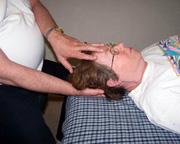 A
variation on the Unified Cranial Vault Hold is what we have named the Emily
Rose. Fingers of the right hand: pointer finger GB20, middle finger
center of the spine at occipital ridge, rings finger GB20. Fingers of
the left hand: pointer and ring on the GB14's, middle on the third eye.
Then simply hold and see what happens. We call this the "Emily Rose"
because it seems very effective in inducing a total neck unwinding.
A
variation on the Unified Cranial Vault Hold is what we have named the Emily
Rose. Fingers of the right hand: pointer finger GB20, middle finger
center of the spine at occipital ridge, rings finger GB20. Fingers of
the left hand: pointer and ring on the GB14's, middle on the third eye.
Then simply hold and see what happens. We call this the "Emily Rose"
because it seems very effective in inducing a total neck unwinding.
Home Page |
Mike's Biography and Training |
Treatment Information |
Mike's Recommendations |
Mike's Writing
(c) 2005-2007 Mike Uggen,
Phone: (317) 297-7263
Cell: (317) 508-8556
WA License Number 16912
Web Design by Barbara Uggen-Davis
 Winning Hands Massage
Winning Hands Massage Winning Hands Massage
Winning Hands Massage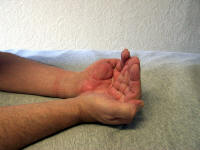
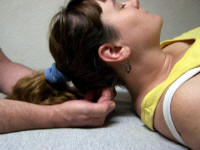
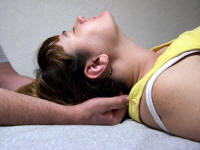
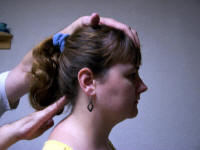
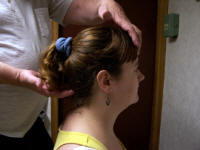
 The Sphenoid is a butterfly (or bat) shaped bone behind the eyes. It has a
section (the Vomer) that rests along the upper side of the hard palette, and
articulates with the Occipital bone at the base of the skull. The hydraulic
action of the cerebral spinal fluid causes the sphenoid to rock toward the
feet and back. In more cases than not, I find this to be stuck or erratic.
The significance is that the rocking motion of the sphenoid pumps the
pituitary gland, which is the primary, and controlling, gland in the body.
An improperly rocking sphenoid can have a direct bearing on endocrine system
function. This is another thing not taught in medical schools in the United
States.
Adjustment technique is to draw the thumbs down toward the table until a
resistance is felt. Pressure is then maintained until it releases, which
will feel like the thumbs are being pulled back toward the ceiling. This is
the manual, physical manipulation way of doing it. It can also be done
purely energetically by focusing intention on sense of movement.
Cranial Vault Hold – Unified Rhythm
There is no question about the ability of energy to physically move bones
with nothing more than light, passive touch. In effect, the body being
worked on in some fashion keys in to the vibratory frequencies emitted by
the therapist’s hands and then literally adjusts itself. One of the real
beauties of this approach is that it is totally non-invasive and therefore
not only extremely gentle but also very safe to do.
After our last road trip in 2005, I got thinking. If energy moves bones in a
way that allows the skeleton to adjust itself (and I know it does because I
have seen and felt the results in the high dozens if not hundreds of times
now), then why not the cranial bones as well? After all, that’s what the
skull is made of – bones. Specifically, there are the bilateral parietal and
temporal bones and the single frontal, occipital, and sphenoid bones.
I have been incorporating pieces of Craniosacral Therapy in my treatment
sessions all along, but basically doing them as taught except for doing as
many of them as I can purely energetically instead of with an actual
physical manipulation.
In thinking about CST and general energy work through the skeletal
structure, I began to feel/believe that there was no conceptual reason why
the cranial bones wouldn’t do the same thing. In other words, instead of
having to assess and treat all of the various restrictions individually, it
should be possible to come up with some kind of hand hold or position that
would also allow all of the various cranial adjustments to just take place
on their own.
While I obviously can’t yet “prove” that my theory is valid, I no longer
have any personal doubt in my own mind. My normal treatment routine had been
to first entrain and then shift into a Cranial Base Release, followed by a
Sphenoid adjustment. In doing those techniques, I was also assessing the
cranial rhythm for energetic balance. About six months ago, while working on
someone and just as I was about to change hand positions, I felt the cranial
rhythm in a way that I had never before experienced it and the
way I
think it is MEANT to be felt.
Specifically, instead of feeling for the lateral, side to side, rhythm of
the paired bones and the proximal-distal rhythm of the single bones
separately, I now believe that in the big picture, a better way of assessing
and working with the rhythm is to view it as three dimensional, to view it,
not as across flat planes, but as a unified, combined rhythm. It is somewhat
like air being blown into and then let out of a balloon in a controlled
fashion (and I am NOT calling any of my family air heads here).
The basic hand hold is to cradle the skull with the fingers on the Gall
Bladder 20s and occipital ridge while the thumbs rest against the side of
the face, along the parietal-temporal suture line. Tips of the thumbs are
approximately at the corners of the eyes depending on length of
practitioner’s thumbs and size of client’s head. And that is it. Simply hold
this position until that unified rhythm kicks in.
The Sphenoid is a butterfly (or bat) shaped bone behind the eyes. It has a
section (the Vomer) that rests along the upper side of the hard palette, and
articulates with the Occipital bone at the base of the skull. The hydraulic
action of the cerebral spinal fluid causes the sphenoid to rock toward the
feet and back. In more cases than not, I find this to be stuck or erratic.
The significance is that the rocking motion of the sphenoid pumps the
pituitary gland, which is the primary, and controlling, gland in the body.
An improperly rocking sphenoid can have a direct bearing on endocrine system
function. This is another thing not taught in medical schools in the United
States.
Adjustment technique is to draw the thumbs down toward the table until a
resistance is felt. Pressure is then maintained until it releases, which
will feel like the thumbs are being pulled back toward the ceiling. This is
the manual, physical manipulation way of doing it. It can also be done
purely energetically by focusing intention on sense of movement.
Cranial Vault Hold – Unified Rhythm
There is no question about the ability of energy to physically move bones
with nothing more than light, passive touch. In effect, the body being
worked on in some fashion keys in to the vibratory frequencies emitted by
the therapist’s hands and then literally adjusts itself. One of the real
beauties of this approach is that it is totally non-invasive and therefore
not only extremely gentle but also very safe to do.
After our last road trip in 2005, I got thinking. If energy moves bones in a
way that allows the skeleton to adjust itself (and I know it does because I
have seen and felt the results in the high dozens if not hundreds of times
now), then why not the cranial bones as well? After all, that’s what the
skull is made of – bones. Specifically, there are the bilateral parietal and
temporal bones and the single frontal, occipital, and sphenoid bones.
I have been incorporating pieces of Craniosacral Therapy in my treatment
sessions all along, but basically doing them as taught except for doing as
many of them as I can purely energetically instead of with an actual
physical manipulation.
In thinking about CST and general energy work through the skeletal
structure, I began to feel/believe that there was no conceptual reason why
the cranial bones wouldn’t do the same thing. In other words, instead of
having to assess and treat all of the various restrictions individually, it
should be possible to come up with some kind of hand hold or position that
would also allow all of the various cranial adjustments to just take place
on their own.
While I obviously can’t yet “prove” that my theory is valid, I no longer
have any personal doubt in my own mind. My normal treatment routine had been
to first entrain and then shift into a Cranial Base Release, followed by a
Sphenoid adjustment. In doing those techniques, I was also assessing the
cranial rhythm for energetic balance. About six months ago, while working on
someone and just as I was about to change hand positions, I felt the cranial
rhythm in a way that I had never before experienced it and the
way I
think it is MEANT to be felt.
Specifically, instead of feeling for the lateral, side to side, rhythm of
the paired bones and the proximal-distal rhythm of the single bones
separately, I now believe that in the big picture, a better way of assessing
and working with the rhythm is to view it as three dimensional, to view it,
not as across flat planes, but as a unified, combined rhythm. It is somewhat
like air being blown into and then let out of a balloon in a controlled
fashion (and I am NOT calling any of my family air heads here).
The basic hand hold is to cradle the skull with the fingers on the Gall
Bladder 20s and occipital ridge while the thumbs rest against the side of
the face, along the parietal-temporal suture line. Tips of the thumbs are
approximately at the corners of the eyes depending on length of
practitioner’s thumbs and size of client’s head. And that is it. Simply hold
this position until that unified rhythm kicks in.
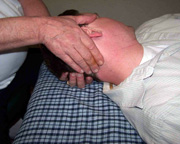
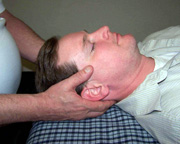
 A
variation on the Unified Cranial Vault Hold is what we have named the Emily
Rose. Fingers of the right hand: pointer finger GB20, middle finger
center of the spine at occipital ridge, rings finger GB20. Fingers of
the left hand: pointer and ring on the GB14's, middle on the third eye.
Then simply hold and see what happens. We call this the "Emily Rose"
because it seems very effective in inducing a total neck unwinding.
A
variation on the Unified Cranial Vault Hold is what we have named the Emily
Rose. Fingers of the right hand: pointer finger GB20, middle finger
center of the spine at occipital ridge, rings finger GB20. Fingers of
the left hand: pointer and ring on the GB14's, middle on the third eye.
Then simply hold and see what happens. We call this the "Emily Rose"
because it seems very effective in inducing a total neck unwinding.